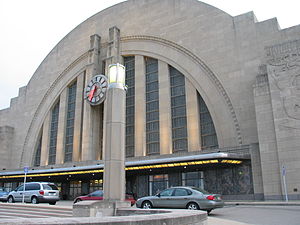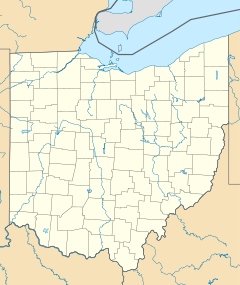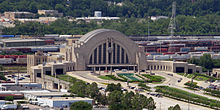- Cincinnati Museum Center at Union Terminal
-
Cincinnati Union Terminal 
Exterior view of the Cincinnati Museum CenterStation statistics Address 1301 Western Avenue
Cincinnati, OHLines CardinalConnections SORTA Platforms 1 Tracks 2 Other information Opened 1933 Rebuilt 1980 Accessible 
Code CIN Owned by City of Cincinnati Traffic Passengers (FY2010) 14,228[1]  3.7% (Amtrak)
3.7% (Amtrak)Services Preceding station Amtrak Following station toward ChicagoCardinal toward New York CityFormer services Baltimore and Ohio Railroad Delhitoward St. LouisSt. Louis Line Winton Placetoward CumberlandTerminus Cincinnati – Toledo Winton Placetoward ToledoCincinnati – Pittsburgh Winton Placetoward PittsburghCincinnati Union TerminalLocation: 1301 Western Ave., Cincinnati, Ohio Coordinates: 39°6′36″N 84°32′16″W / 39.11°N 84.53778°WCoordinates: 39°6′36″N 84°32′16″W / 39.11°N 84.53778°W Built: 1933 Architect: Fellheimer & Wagner Architectural style: Art Deco Governing body: Private NRHP Reference#: 72001018
[2]Added to NRHP: October 31, 1972 The Cincinnati Museum Center at Union Terminal, originally Cincinnati Union Terminal, is a passenger railroad station in the Queensgate neighborhood of Cincinnati, Ohio, United States. After the decline of railroad travel, most of the building was converted to other uses, and now houses museums, theaters, and a library.
Contents
Background
Cincinnati was a major center of railroad traffic in the late 19th and early 20th century, especially as an interchange point between railroads serving the Northeastern and Midwestern states with railroads serving the South. However, intercity passenger traffic was split among no fewer than five stations in Downtown Cincinnati, requiring the many travelers who changed between railroads to navigate local transit themselves.[3] The Louisville and Nashville Railroad, which operated through sleepers with other railroads, was forced to split its operations between two stations.[4] Proposals to construct a union station began as early as the 1890s, and a committee of railroad executives formed in 1912 to begin formal studies on the subject, but a final agreement between all seven railroads that served Cincinnati and the city itself would not come until 1928, after intense lobbying and negotiations, led by Philip Carey Company president George Crabbs.[3] The seven railroads: the Baltimore and Ohio Railroad; the Chesapeake and Ohio Railroad; the Cleveland, Cincinnati, Chicago and St. Louis Railway; the Louisville and Nashville Railroad; the Norfolk and Western Railway; the Pennsylvania Railroad; and the Southern Railway selected a site for their new station in the West End, near the Mill Creek.
Architecture and design
The principal architects of the massive building were Alfred T. Fellheimer and Steward Wagner, with architects Paul Philippe Cret and Roland Wank brought in as design consultants; Cret is often credited as the building's architect, as he was responsible for the building's signature Art Deco style. The Rotunda features the largest semi-dome in the western hemisphere, measuring 180 feet wide and 106 feet high.[5]
The Murals
German artist Winold Reiss was commissioned to design and create two 22 foot (6.7 m) high by 110 foot (33.5 m) long color mosaic murals depicting the history of Cincinnati for the rotunda, two murals for the baggage lobby, two murals for the departing and arriving train boards, 14 smaller murals for the train concourse representing local industries and the large world map mural located at the rear of the concourse. Reiss spent roughly two years in the design and creation of the murals. Many of these murals were removed during subsequent renovations and placed on display at the Cincinnati/Northern Kentucky International Airport. The 14 industries chosen to be depicted were:
- Piano making (Baldwin Piano Company)
- Radio broadcasting (Crosley Broadcasting Corporation)
- Roof manufacture (Philip Carey Co.)
- Tanning (American Oak Leather Co.)
- Airplane and parts manufacture (Aeronca Aircraft Company)
- Ink making (Ault & Weiborg Corp.)
- Laundry-machinery manufacture (American Laundry Machine)
- Meat packing (Kahn's Meat Packing)
- Drug and chemical processing (William S. Merrill Co.)
- Printing and publishing (U.S. Playing Card Co. and Champion Paper Company)
- Foundry products operations (Cincinnati Milling Machine)
- Sheet steel making (American Rolling Mills and Newport Rolling Mill)
- Soap making (The Procter & Gamble Co.)
- Machine tools manufacture (Cincinnati Milling Machine).
Construction
The Union Terminal Company was created to build the terminal itself, the railroad lines into and out of the terminal, and other related transportation improvements. Construction and improvements began in 1928 with the regrading of the east flood plain of the Mill Creek to a point nearly level with the surrounding city, a massive effort that required 5.5 million cubic yards of landfill.[4] Other improvements included the construction of grade separated viaducts over the Mill Creek and the railroad approaches to Union Terminal. The new viaducts the Union Terminal Company created to cross the Mill Creek valley ranged from the well built, like the Western Hills Viaduct,[3] to the more hastily constructed and shabby, like the Waldvogel Viaduct.[6] Construction on the terminal building itself began in 1931, with Cincinnati mayor Russell Wilson laying the mortar for the cornerstone. Construction was finished ahead of schedule,[3] although the terminal welcomed its first trains even earlier on March 19, 1933 when it was forced into emergency operation due to flooding of the Ohio River. The official opening of the station was on March 31, 1933. The total cost of the project was $41.5 million.[citation needed]
Operation
During its heyday as a passenger rail facility, Union Terminal had a capacity of 216 trains per day, 108 in and 108 out. Three concentric lanes of traffic were included in the design of the building, underneath the main rotunda of the building: one for taxis, one for buses, and one (although never used) for streetcars. However, the time period in which the terminal was built was one of decline for train travel. By 1939, local newspapers were already describing the station as a white elephant.[3] While it had a brief revival in the 1940s, because of World War II, it declined in use through the 1950s and the 1960s. In July 1958, Union Terminal was witness to the end of an era as the last mainline passenger steam train in the United States, the Norfolk and Western #603, originated in Cincinnati.[3]
In 1971, after the creation of Amtrak, train service at Union Terminal was reduced to just two trains a day, the George Washington and the James Whitcomb Riley. Amtrak abandoned Union Terminal the next year, opening a smaller station elsewhere in Cincinnati on October 29, 1972.[3]
Named trains of Cincinnati's Union Terminal
Name Operators Year begun Year discontinued Cardinal Amtrak 1977 Cincinnati Limited PRR, PC 1971 Cincinnati Mercury NYC Cincinnatian B & O 1947 1971 Cavalier N & W George Washington C & O, Amtrak 1974 Humming Bird L & N 1968 James Whitcomb Riley NYC, PC, Amtrak 1977 Metropolitan Special B & O 1971 National Limited B & O Northern Arrow PRR 1961 Ohio State Limited NYC, PC Pan-American L & N 1921 1971 Pocahontas N & W 1971 Powhatan Arrow N & W 1946 Royal Palm SOU Xplorer NYC 1956 Abandonment and reduction
After Amtrak abandoned the station, Southern Railway purchased some of the land to use for its own expanded freight operations in its Gest Street yard. The Southern planned on removing the 450-foot (140 m) long passenger train concourse to allow additional height for its piggyback operations. On May 15, 1973 the Cincinnati City Council's Urban Development and Planning Committee voted 3–1 in favor of designating Union Terminal for preservation as an historic landmark, preventing Southern Railway from destroying the entire building. In 1974, the Southern Railway did tear down most of the train concourse, an action that has since been regretted by the railroad.[citation needed] Before the concourse was destroyed, the fourteen mosaic murals depicting important Cincinnati industries were removed by Besl Transfer Company from the concourse and installed at the Cincinnati/Northern Kentucky International Airport. The only mural which was not preserved was the world map, which was destroyed when the concourse was removed.
Several plans were floated for reuse of the building in the 1970s, including a plan to locate a Southwest Ohio Regional Transit Authority transit hub and the School for Creative and Performing Arts in the building, but these never materialized.[3]
Shopping mall
In 1978, Columbus, Ohio real estate development group the Joseph Skilken Organization converted the terminal into a shopping mall known as the "Land of OZ". This was projected to be a family entertainment and shopping complex including a shopping area, roller skating rink, bowling alleys, and restaurants. Skilken invested upwards of $20 million in renovations preparing the terminal in the hope that this would revitalize the complex and help keep people in downtown Cincinnati.
These plans were put into action and on August 4, 1980, after 23 months of conversion construction, the mall had its Grand Opening, with 40 tenants. The complex drew on average 7,900 visitors per day and it would see a high of 54 shops or vendors. The recession of the early 1980s caused the project to fall on hard times. In 1981 the first tenant moved out and by 1982 the number of tenants had fallen to 21. Also in August 1982, the Cincinnati Museum of Health, Science and Industry opened in the terminal. The OZ project officially closed in 1984. However, Loehmann's, a clothing store located in the rotunda remained open until 1985. The passenger drop off ramps that ran under the rotunda were used for a weekend flea market for several years.
Museum Center (and a return to use as a train station)
The terminal lay empty for the next decade or so. In May 1986 the voters of Hamilton County passed a bond levy to save the terminal from destruction and to transform it into the Cincinnati Museum Center. Former Cincinnati mayor Jerry Springer was one of the major proponents of saving the building and transforming it into a museum. It was opened in 1990 and now provides a home to six organizations:
- Cincinnati History Museum
- Museum of Natural History & Science
- Robert D. Lindner Family Omnimax Theater
- Cincinnati Historical Society Library
- Duke Energy Children's Museum
- The Cincinnati Railroad Club
The renovations also allowed Amtrak to restore service to Union Terminal via the thrice-weekly Cardinal on July 29, 1991. Of the seven Ohio stations served by Amtrak, Cincinnati was the third busiest in FY2010, boarding or detraining an average of approximately 40 passengers daily.
The Cincinnati Railroad Club occupies "Tower A" above the station, offers public access to the space, and serves as a museum for the former rail yard and station's innovative interlocking system of remote-controlled track switches.
In Popular Culture
The Art Deco design of Union Terminal inspired the look of the Hall of Justice, the iconic headquarters of DC Comics' Justice League. The Hall of Justice first appeared in the Superfriends animated TV series of the 1970s. It is still used today in DC's current Justice League comics series.
Union Terminal's radio-like design also appears briefly in Batman Forever (represented by a matte painting) as "the Hippodrome," a sports arena. In the film, it is the place where the Haley Bros. Circus performs, and where Dick Grayson's family is killed by Two-Face.
Sources
- Darbee, Jeffrey T. (2003). A Tale of Three Cities:The Union Stations of Cleveland, Columbus and Cincinnati, Indiana Historical Society on-line.
- Mecklenborg, Jake(2005). Cincinnati-Transit.net.
- Spurlock, William(2005). The Railroad Architecture of Alfred T. Fellheimer.
- The Railroad and the City, A Techonological and Urbanistic History of Cincinnati, Written by Carl W. Condit. 1977, Ohio State University Press. ISBN 0-8142-0265-9
- Works Progress Administration(ed. Harry Graff)(1943). WPA Guide to Cincinnati: Cincinnati, a guide to the Queen City and its neighbors. Cincinnati: The Cincinnati Historical Society. ISBN 0-911497-04-8.
References
- ^ "Amtrak Fact Sheet, FY2010, State of Ohio" (PDF). Amtrak. November 2010. http://www.amtrak.com/pdf/factsheets/OHIO10.pdf. Retrieved 2011-01-06.
- ^ "National Register Information System". National Register of Historic Places. National Park Service. 2008-04-15. http://nrhp.focus.nps.gov/natreg/docs/All_Data.html.
- ^ a b c d e f g h writers, Linda C. Rose, Patrick Rose, Gibson Yungblut ; editors, Linda C. Rose ... et al. (October 1999). Cincinnati Union Terminal: The Design and Construction of an Art Deco Masterpiece. Cincinnati, Ohio: Cincinnati Railroad Club, Inc.. ISBN 0-9676125-0-0.
- ^ a b "Cincinnati's New Union Terminal Now in Service". Railway Age 94 (16): 575–590. 1933.
- ^ Cincinnati Union Terminal Architectural Information Sheet. Cincinnati Museum Center. Retrieved on February 8, 2010.
- ^ Waldvogel Viaduct
External links
- Cincinnati Museum Center at Union Terminal website
- Northern Cincinnati Convention & Visitors Bureau
- Cincinnati Historical Society Library website
- Building review incorporating images from the Historic American Buildings Survey
- The Railroad Architecture of Alfred T. Fellheimer
- Union Terminal Mosaics
- 360˚ interactive panoramas of Union Terminal Exterior and rotunda
- Railroads of Cincinnati Contemporary and historical Cincinnati railroads
- Cincinnati Union Terminal Photos – interior and exterior
- Union Terminal Photographs
- Amtrak – Stations – Cincinnati, OH
U.S. National Register of Historic Places Topics Lists by states Alabama • Alaska • Arizona • Arkansas • California • Colorado • Connecticut • Delaware • Florida • Georgia • Hawaii • Idaho • Illinois • Indiana • Iowa • Kansas • Kentucky • Louisiana • Maine • Maryland • Massachusetts • Michigan • Minnesota • Mississippi • Missouri • Montana • Nebraska • Nevada • New Hampshire • New Jersey • New Mexico • New York • North Carolina • North Dakota • Ohio • Oklahoma • Oregon • Pennsylvania • Rhode Island • South Carolina • South Dakota • Tennessee • Texas • Utah • Vermont • Virginia • Washington • West Virginia • Wisconsin • WyomingLists by territories Lists by associated states Other Categories:- 1933 architecture
- Art Deco architecture in Ohio
- History museums in Ohio
- Museums in Cincinnati, Ohio
- National Historic Landmarks in Ohio
- Natural history museums in Ohio
- Railway stations on the National Register of Historic Places in Ohio
- Rotundas
- Science museums in Ohio
- Paul Philippe Cret buildings
- Railroad museums in Ohio
- Domes
- Clock towers in the United States
Wikimedia Foundation. 2010.






